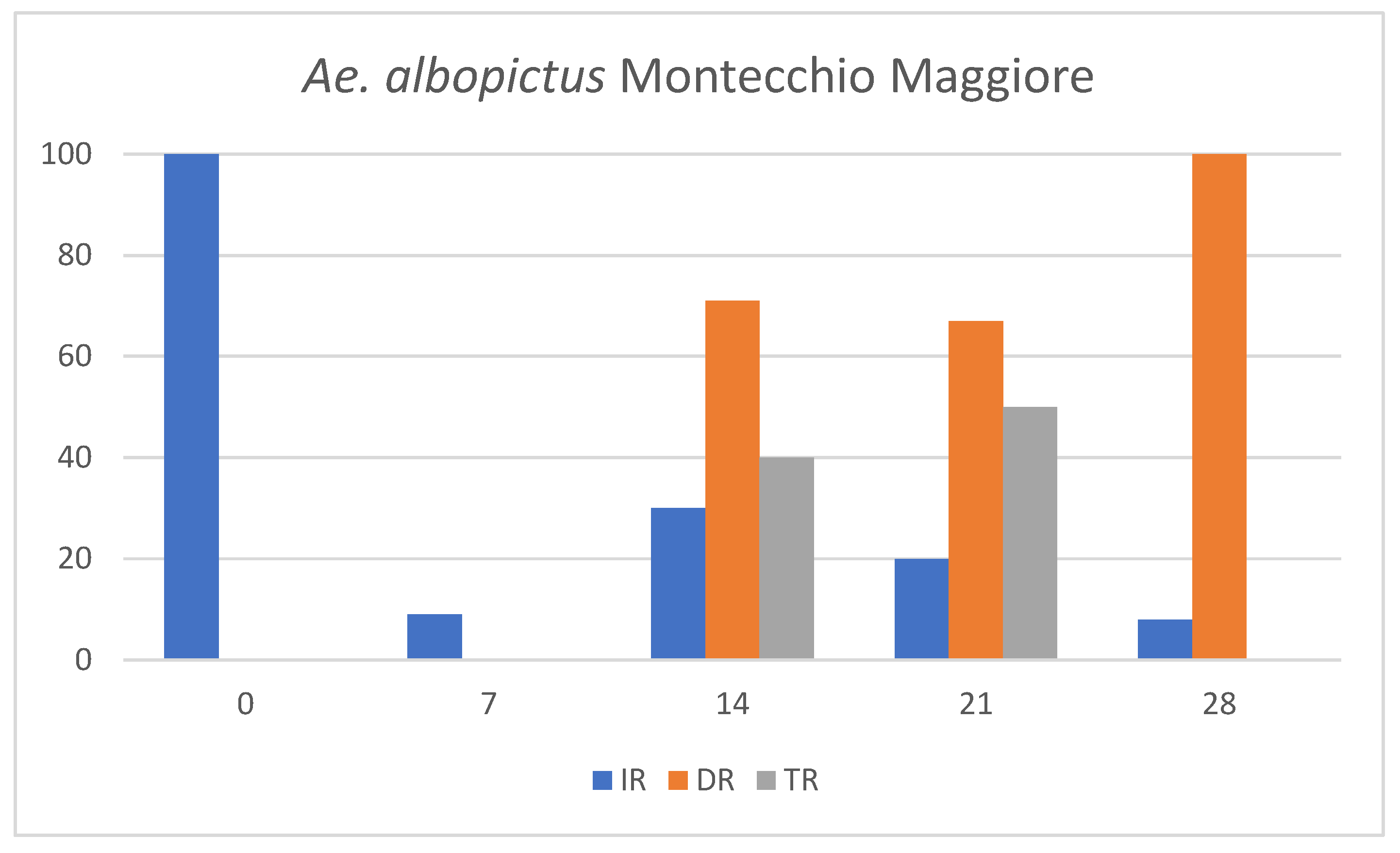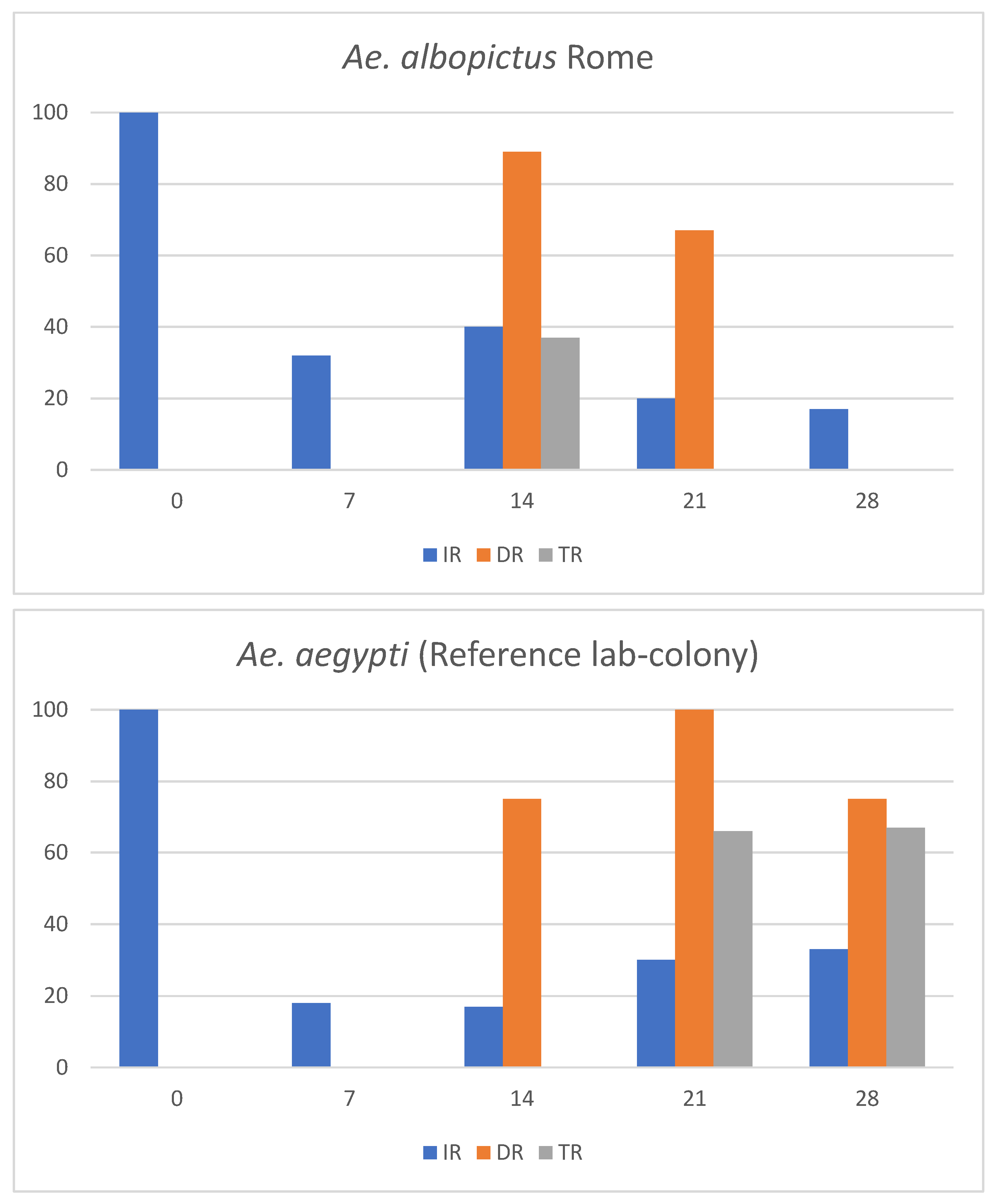Assessing the Risk of Dengue Virus Local Transmission: Study on Vector Competence of Italian Aedes albopictus
Abstract
1. Introduction
2. Materials and Methods
2.1. Virus and Mosquito Populations
2.2. Genetic Similarity Analysis
2.3. Experimental Infection
2.4. Data Analysis and Statistics
3. Results
4. Discussion
Supplementary Materials
Author Contributions
Funding
Institutional Review Board Statement
Informed Consent Statement
Data Availability Statement
Conflicts of Interest
References
- Gubler, D.J.; Ooi, E.E.; Vasudevan, S.; Farrar, J. Dengue and Dengue Hemorrhagic Fever, 2nd ed.; CABI: Wallingford, UK, 2014. [Google Scholar]
- Bellone, R.; Lequime, S.; Jupille, H.; Göertz, G.P.; Aubry, F.; Mousson, L.; Piorkowski, G.; Yen, P.S.; Gabiane, G.; Vazeille, M.; et al. Experimental adaptation of dengue virus 1 to Aedes albopictus mosquitoes by in vivo selection. Sci. Rep. 2020, 10, 18404. [Google Scholar] [CrossRef] [PubMed]
- Lazzarini, L.; Barzon, L.; Foglia, F.; Manfrin, V.; Pacenti, M.; Pavan, G.; Rassu, M.; Capelli, G.; Montarsi, F.; Martini, S.; et al. First autochthonous dengue outbreak in Italy, August 2020. Eurosurveillance 2020, 25, 2001606. [Google Scholar] [CrossRef] [PubMed]
- McAuley, A.J.; Beasley, D.W.C. Propagation and Titration of West Nile Virus on Vero Cells. Methods Mol. Biol. 2016, 1435, 19–27. [Google Scholar] [CrossRef] [PubMed]
- Drosten, C.; Göttig, S.; Schilling, S.; Asper, M.; Panning, M.; Schmitz, H.; Günther, S. Rapid detection and quantification of RNA of Ebola and Marburg viruses, Lassa virus, Crimean-Congo hemorrhagic fever virus, Rift Valley fever virus, dengue virus, and yellow fever virus by real-time reverse transcription-PCR. J. Clin. Microbiol. 2002, 40, 2323–2330. [Google Scholar] [CrossRef] [PubMed]
- Dubrulle, M.; Mousson, L.; Moutailler, S.; Vazeille, M.; Failloux, A.B. Chikungunya virus and Aedes mosquitoes: Saliva is infectious as soon as two days after oral infection. PLoS ONE 2009, 4, e5895. [Google Scholar] [CrossRef] [PubMed]
- Fortuna, C.; Remoli, M.E.; Di Luca, M.; Severini, F.; Toma, L.; Benedetti, E.; Bucci, P.; Montarsi, F.; Minelli, G.; Boccolini, D.; et al. Experimental studies on comparison of the vector competence of four Italian Culex pipiens populations for West Nile virus. Parasites Vectors 2015, 8, 463. [Google Scholar] [CrossRef] [PubMed]
- Lanciotti, R.S.; Kosoy, O.L.; Laven, J.J.; Velez, J.O.; Lambert, A.J.; Johnson, A.J.; Stanfield, S.M.; Duffy, M.R. Genetic and serologic properties of Zika virus associated with an epidemic, Yap State, Micronesia, 2007. Emerg. Infect. Dis. 2008, 14, 1232–1239. [Google Scholar] [CrossRef] [PubMed]
- Richards, S.L.; Mores, C.N.; Lord, C.C.; Tabachnick, W.J. Impact of extrinsic incubation temperature and virus exposure on vector competence of Culex pipiens quinquefasciatus Say (Diptera: Culicidae) for West Nile virus. Vector Borne Zoonotic Dis. 2007, 7, 629–636. [Google Scholar] [CrossRef] [PubMed]
- Bhatt, S.; Gething, P.W.; Brady, O.J.; Messina, J.P.; Farlow, A.W.; Moyes, C.L.; Drake, J.M.; Brownstein, J.S.; Hoen, A.G.; Sankoh, O.; et al. The global distribution and burden of dengue. Nature 2013, 496, 504–507. [Google Scholar] [CrossRef]
- Aranda, C.; Martínez, M.J.; Montalvo, T.; Eritja, R.; Navero-Castillejos, J.; Herreros, E.; Marqués, E.; Escosa, R.; Corbella, I.; Bigas, E.; et al. Arbovirus surveillance: First dengue virus detection in local Aedes albopictus mosquitoes in Europe, Catalonia, Spain, 2015. Eurosurveillance 2018, 23, 1700837. [Google Scholar] [CrossRef] [PubMed]
- European Centre for Disease Prevention and Control. Dengue Worldwide Overview. 2023. Available online: https://www.ecdc.europa.eu/en/dengue-monthly (accessed on 30 December 2023).
- Epicentro Istituto Superiore di Sanità. Arbovirosi in Italia. 2023. Available online: https://www.epicentro.iss.it/arbovirosi/dashboard (accessed on 30 December 2023).
- Cochet, A.; Calba, C.; Jourdain, F.; Grard, G.; Durand, G.A.; Guinard, A.; Noël, H.; Paty, M.C.; Franke, F. Autochthonous dengue in mainland France, 2022: Geographical extension and incidence increase. Eurosurveillance 2022, 27, 2200818. [Google Scholar] [CrossRef]
- Soni, M.; Khan, S.A.; Bhattacharjee, C.K.; Dutta, P.J. Experimental study of dengue virus infection in Aedes aegypti and Aedes albopictus: A comparative analysis on susceptibility, virus transmission and reproductive success. Invertebr. Pathol. 2020, 175, 107445. [Google Scholar] [CrossRef] [PubMed]
- Lindh, E.; Argentini, C.; Remoli, M.E.; Fortuna, C.; Faggioni, G.; Benedetti, E.; Amendola, A.; Marsili, G.; Lista, F.; Rezza, G.; et al. The Italian 2017 Outbreak Chikungunya Virus Belongs to an Emerging Aedes albopictus-Adapted Virus Cluster Introduced from the Indian Subcontinent. In Open Forum Infectious Diseases; Oxford University Press: New York, NY, USA, 2018. [Google Scholar] [CrossRef]
- Khongwichit, S.; Chansaenroj, J.; Chirathaworn, C.; Poovorawan, Y.J. Chikungunya virus infection: Molecular biology, clinical characteristics, and epidemiology in Asian countries. Biomed. Sci. 2021, 28, 84. [Google Scholar] [CrossRef] [PubMed]
- Koo, C.; Ping Tien, W.; Xu, H.; Ong, J.; Rajarethinam, J.; Ling Lai, Y.; Ng, L.C.; Hapuarachchi, H.C. Highly Selective Transmission Success of Dengue Virus Type 1 Lineages in a Dynamic Virus Population: An Evolutionary and Fitness Perspective. iScience 2018, 6, 38–51. [Google Scholar] [CrossRef]


| Species | Days Post Infection | IR | Main Value (PFU/mL) | DR | Main Value (PFU/mL) | TR | Main Value (PFU/mL) |
|---|---|---|---|---|---|---|---|
| Ae. albopictus Rome | 0 | 11/11 | 1.6 × 101 | - | - | ||
| 7 | 7/21 | 6.3 × 101 | 0/7 | 0/7 | |||
| 14 | 9/22 | 7.6 × 102 | 8/9 | 1.3 × 101 | 3/9 | 0.4 × 101 | |
| 21 | 3/15 | 3.0 × 102 | 2/3 | 0.7 × 101 | 0/3 | ||
| 28 | 2/12 | 4.1 × 102 | 0/2 | 0/2 | |||
| Ae. albopictus Montecchio M. | 0 | 12/12 | 1.9 × 101 | - | - | ||
| 7 | 2/22 | 2.4 × 101 | 0/2 | 0/2 | |||
| 14 | 7/23 | 3.8 × 102 | 5/7 | 0.2 × 101 | 2/7 | 0.1 × 101 | |
| 21 | 3/15 | 6.4 × 102 | 2/3 | 0.5 × 101 | 1/3 | 0.5 × 101 | |
| 28 | 1/12 | 7.4 × 102 | 1/1 | 4.4 × 101 | 0/1 | ||
| Ae. aegypti Reynosa | 0 | 12/12 | 3.5 × 101 | - | - | ||
| 7 | 4/22 | 1.9 × 101 | 0/4 | 0/4 | |||
| 14 | 4/23 | 4.2 × 101 | 3/4 | 0.5 × 101 | 0/4 | ||
| 21 | 3/10 | 1.4 × 103 | 3/3 | 1 × 101 | 2/3 | 0.2 × 101 | |
| 28 | 4/12 | 1.9 × 102 | 3/4 | 3.3 × 101 | 2/4 | 0.2 × 101 |
| Ae. albopictus Rome | Ae. albopictus Montecchio M. | Ae. aegypti Reference Lab-Colony | |
|---|---|---|---|
| IR | 30% | 18% | 22% |
| DR | 48% | 61% | 60% |
| TR | 14% | 23% | 27% |
| VCI | 0.04 | 0.04 | 0.06 |
Disclaimer/Publisher’s Note: The statements, opinions and data contained in all publications are solely those of the individual author(s) and contributor(s) and not of MDPI and/or the editor(s). MDPI and/or the editor(s) disclaim responsibility for any injury to people or property resulting from any ideas, methods, instructions or products referred to in the content. |
© 2024 by the authors. Licensee MDPI, Basel, Switzerland. This article is an open access article distributed under the terms and conditions of the Creative Commons Attribution (CC BY) license (https://creativecommons.org/licenses/by/4.0/).
Share and Cite
Fortuna, C.; Severini, F.; Marsili, G.; Toma, L.; Amendola, A.; Venturi, G.; Argentini, C.; Casale, F.; Bernardini, I.; Boccolini, D.; et al. Assessing the Risk of Dengue Virus Local Transmission: Study on Vector Competence of Italian Aedes albopictus. Viruses 2024, 16, 176. https://doi.org/10.3390/v16020176
Fortuna C, Severini F, Marsili G, Toma L, Amendola A, Venturi G, Argentini C, Casale F, Bernardini I, Boccolini D, et al. Assessing the Risk of Dengue Virus Local Transmission: Study on Vector Competence of Italian Aedes albopictus. Viruses. 2024; 16(2):176. https://doi.org/10.3390/v16020176
Chicago/Turabian StyleFortuna, Claudia, Francesco Severini, Giulia Marsili, Luciano Toma, Antonello Amendola, Giulietta Venturi, Claudio Argentini, Francesca Casale, Ilaria Bernardini, Daniela Boccolini, and et al. 2024. "Assessing the Risk of Dengue Virus Local Transmission: Study on Vector Competence of Italian Aedes albopictus" Viruses 16, no. 2: 176. https://doi.org/10.3390/v16020176
APA StyleFortuna, C., Severini, F., Marsili, G., Toma, L., Amendola, A., Venturi, G., Argentini, C., Casale, F., Bernardini, I., Boccolini, D., Fiorentini, C., Hapuarachchi, H. C., Montarsi, F., & Di Luca, M. (2024). Assessing the Risk of Dengue Virus Local Transmission: Study on Vector Competence of Italian Aedes albopictus. Viruses, 16(2), 176. https://doi.org/10.3390/v16020176








